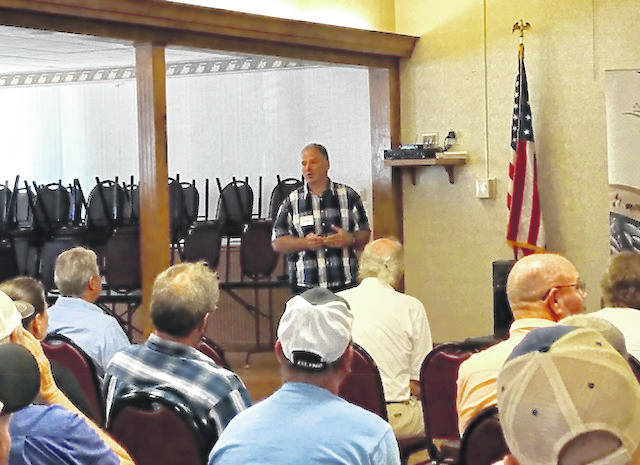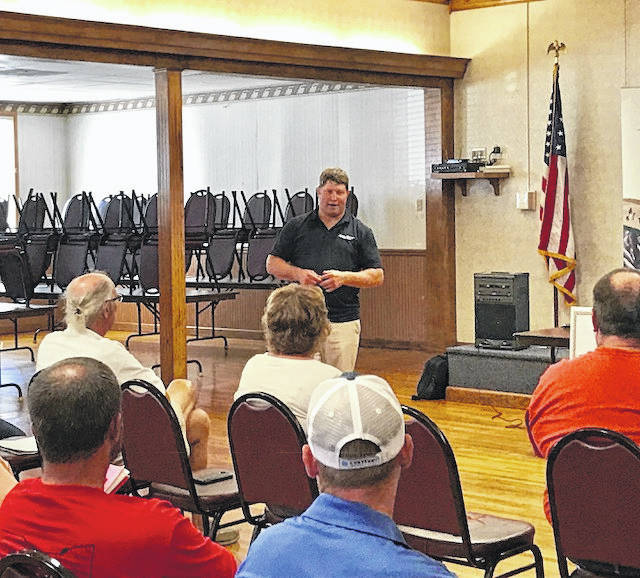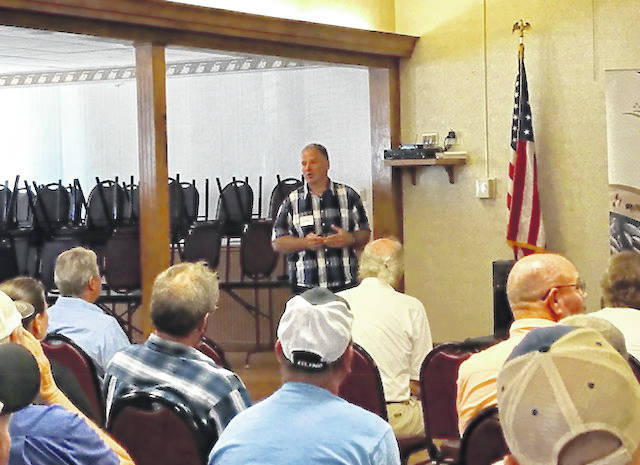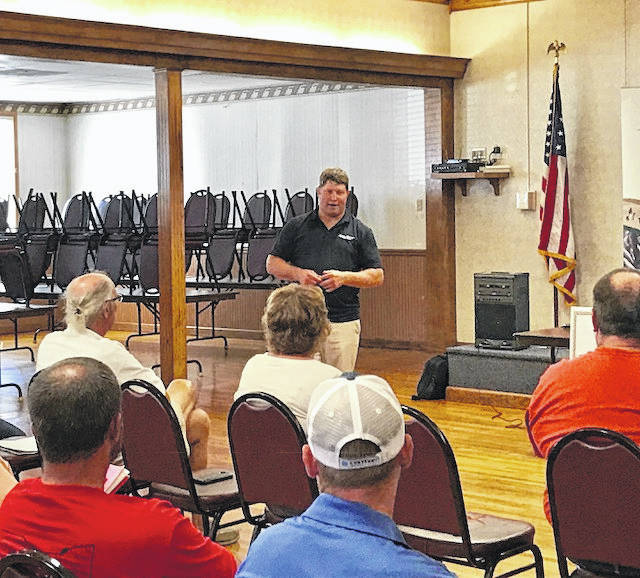



MARIA STEIN — The vice chairperson of Dairy Farmers of Ontario, Murray Sherk, was welcomed by the Ohio Farmers Union, as well as area farmers, at the Maria Stein American Legion Auxiliary Post 571, in Mercer County, on Tuesday, where he led an informative discussion regarding the Canadian dairy supply management system.
Sherk shared his perspective, to a crowd of about 25 people, on the pros and cons of the system along with how, or if, a similar system could be implemented in the United States.
This event was part of a series of forums to be held around the nation that will highlight impacts of dairy policy, including supply management, on dairy farming communities.
According to the Ohio Farmers Union, since 2013, net farm income for U.S. farmers has declined 50 percent. Median farm income for 2017 is projected to be negative $1,325, and many commodities remain below the cost of production.
Further, a direct correlation between farm economics and farmer mental health has been discovered. Farmer suicide rates are rising, and people in agriculture are more likely than any other occupation to take their own life.
These forums are in response to these statistics and are being organized by the Ohio Farmers Union, the Wisconsin Farmers Union, the National Farmers Organization and the National Farmers Union.
Joe Logan, president of the Ohio Farmers Union, and Darin Von Ruden, president of the Wisconsin Farmers Union, were also in attendance to help lead Tuesday’s meeting.
Logan opened the forum by recognizing the hard work that comes with being a farmer, as well as the dedication and sacrifice they, along with their families, give daily while still often struggling to make ends meet.
“That’s the situation in which we find ourselves in the dairy industry right now,” he said.
“What we are trying to do,” Logan continued, “is to get information into people’s hands about the possibilities and alternatives that exist for policy in the dairy industry.”
Von Ruden, who introduced himself as a lifelong farmer, said he was compelled to join the political side of agriculture after his parents’ farm was affected by farming crises in the 1990s.
“(I wanted to know) if there was a way to change things,” he said.
Von Ruden pointed out that there seems to be a “massive move” toward larger farms in the country, leaving the smaller caliber farms and farmers at a bit of a loss.
“Is that what we, as a country, really want to see?”
These smaller farms are often left scrambling to find another market in which to sell their dairy in response to inconsistent milk prices and competition that leaves them without a buyer.
“If you look at how Canada and some other countries around the world that have supply management programs, every farmer, as a whole, either (benefits) when there’s positives or suffers when there’s a loss,” Von Ruden said. “It isn’t just a certain hand-picked few, it’s absorbed by all.”
“I remember back in the days when neighbors helped neighbors out and looked out for each other,” he continued. “We’re really moving away from that in this country, where it’s neighbor against neighbor. I don’t think that’s the right mentality to have. We all have to work together to make sure we all survive.”
An major theme of the forum was a focus on change within the dairy farming industry.
“What that’s going to be is still kind of an unknown, but we have to do something different,” Von Ruden said.
The floor was opened for a short segment of comments from those in attendance.
Myron Stammen, who comes from a farming family, shared that his parents had a 240-acre farm, no off-farm income, and were able to afford new farm equipment, new vehicles, and improvements to their land. This is in great contrast to the current-day plite of many American farmers.
Stammen said a “common sense” solution is needed.
Murray Sherk, of Plattsville, Ontario, is the soon-to-be president of the Dairy Farmers of Ontario. He and his wife, Sandra, along with their four daughters, live on a 500-acre farm with 130 dairy cows.
Sherk shared that Canada’s dairy system is known as “supply management,” which provides balance in the dairy sector by enabling Canadian dairy farmers to act collectively to negotiate price and adjust milk production to meet consumer demand.
“In Ontario, if you’re going to sell milk, it’s got to be sold to the Dairy Farmers of Ontario and we’re the central marketing agency for all the milk,” he said.
DFO is governed by a 12-member board of farmers.
The supply management system has been in place since the 1970s, and provides a more steady market for the dairy industry, Sherk said.
“One of the things I would say is a benefit to stability is you can largely predict what income you’re going to make down the road,” he said.
Sherk pointed out the prolonged inconsistency in milk prices in the United States, as well as other countries around the world, compared to the overall steady pricing of Canadian dairy.
This steady pricing results in the Canadian dairy farming being one of the few agricultural sectors that are self-sufficient, which provides income security for farmers while requiring no government subsidy.
At a national level in Canada, market requirements are determined to meet domestic consumer demand and avoid overproduction. A National Production Quota is issued to provinces based on percentages. The provinces, then, issue a quota to producers.
One attendee pointed out that America has a “co-op” system within the dairy industry in many places throughout the country, which is similar, in a basic sense, to the system used in Canada.
Von Ruden said the answer may lie in who is operated these co-operative systems. In Canada, the system is not government-run, leaving more control in the hands of the farmers, or producers.
“Here in the U.S., we’ve relied on the National Milk Producers Federation to represent us in Washington, D.C., on policy issues,” Von Ruden said. “Nine times out of ten, they’re actually representing the processing side of the co-op, not the producer’s side. It’s a matter of us as dairy farmers who are members of those cooperatives (to) take a stand and say, ‘No, you need to start representing our interests first.’”
“Of course, we need the processors, too, so we’ve got to be able to figure that balance out because, in the end, we all have to beneficiaries, not just one side of the industry.”
The Ohio Farmers Union is proposing a new farm bill in 2018 to include an emergency relief provision for dairy farmers, practical dairy supply management that includes both farmers and processors, and stable prices for farmers.
To learn more about this movement toward a more stable dairy industry, visit www.dairytogether.com.



